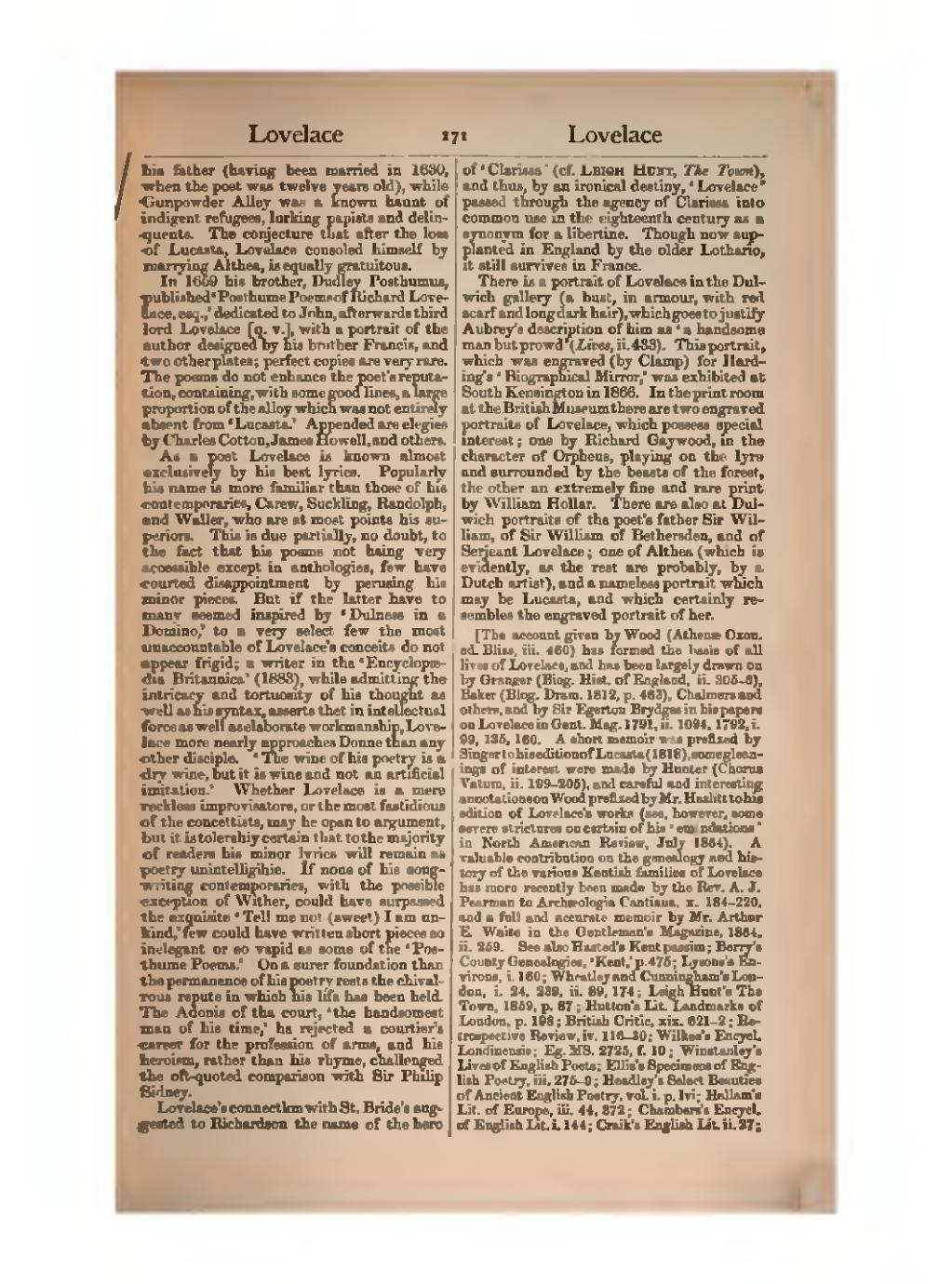his father (having been married in 1630, when the poet was twelve years old), while Gunpowder Alley was a known haunt of indigent refugees, lurking papists and delinquents. The conjecture that after the loss of Lucasta, Lovelace consoled himself by marrying Althea, is equally gratuitous.
In 1659 his brother, Dudley Posthumus, published ‘Posthume Poems of Richard Lovelace, esq.,’ dedicated to John, afterwards third lord Lovelace [q. v.], with a portrait of the author designed by his brother Francis, and two other plates; perfect copies are very rare. The poems do not enhance the poet's reputation, containing, with some good lines, a large proportion of the alloy which was not entirely absent from ‘Lucasta.’ Appended are elegies by Charles Cotton, James Howell, and others.
As a poet Lovelace is known almost exclusively by his best lyrics. Popularly his name is more familiar than those of his contemporaries, Carew, Suckling, Randolph, and Waller, who are at most points his superiors. This is due partially, no doubt, to the fact that his poems not being very accessible except in anthologies, few have courted disappointment by perusing his minor pieces. But if the latter have to many seemed inspired by ‘Dulness in a Domino,’ to a very select few the most unaccountable of Lovelace's conceits do not appear frigid; a writer in the ‘Encyclopædia Britannica’ (1883), while admitting the intricacy and tortuosity of his thought as well as his syntax, asserts that in intellectual force as well as elaborate workmanship, Lovelace more nearly approaches Donne than any other disciple. ‘The wine of his poetry is a dry wine, but it is wine and not an artificial imitation.’ Whether Lovelace is a mere reckless improvisatore, or the most fastidious of the concettists, may be open to argument, but it is tolerably certain that to the majority of readers his minor lyrics will remain as poetry unintelligible. If none of his song-writing contemporaries, with the possible exception of Wither, could have surpassed the exquisite ‘Tell me not (sweet) I am unkind,’ few could have written short pieces so inelegant or so vapid as some of the ‘Posthume Poems.’ On a surer foundation than the permanence of his poetry rests the chivalrous repute in which his life has been held. The Adonis of the court, ‘the handsomest man of his time,’ he rejected a courtier's career for the profession of arms, and his heroism, rather than his rhyme, challenged the oft-quoted comparison with Sir Philip Sidney.
Lovelace's connection with St. Bride's suggested to Richardson the name of the hero of ‘Clarissa’ (cf. Leigh Hunt, The Town), and thus, by an ironical destiny, ‘Lovelace’ passed through the agency of Clarissa into common use in the eighteenth century as a synonym for a libertine. Though now supplanted in England by the older Lothario, it still survives in France.
There is a portrait of Lovelace in the Dulwich gallery (a bust, in armour, with red scarf and long dark hair), which goes to justify Aubrey's description of him as ‘a handsome man but prowd’ (Lives, ii. 433). This portrait, which was engraved (by Clamp) for Harding's ‘Biographical Mirror,’ was exhibited at South Kensington in 1866. In the print room at the British Museum there are two engraved portraits of Lovelace, which possess special interest; one by Richard Gaywood, in the character of Orpheus, playing on the lyre and surrounded by the beasts of the forest, the other an extremely fine and rare print by William Hollar. There are also at Dulwich portraits of the poet's father Sir William, of Sir William of Bethersden, and of Serjeant Lovelace; one of Althea (which is evidently, as the rest are probably, by a Dutch artist), and a nameless portrait which may be Lucasta, and which certainly resembles the engraved portrait of her.
